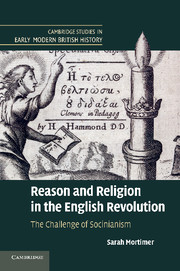Book contents
- Frontmatter
- Contents
- Acknowledgements
- Abbreviations and conventions
- Introduction
- 1 The Socinian challenge to Protestant Christianity
- 2 Socinianism in England and Europe
- 3 The Great Tew Circle: Socinianism and scholarship
- 4 Royalists, Socinianism and the English Civil War
- 5 Socinianism and the Church of England
- 6 Reason, religion and the doctrine of the Trinity
- 7 Anti-Trinitarianism, Socinianism and the limits of toleration
- 8 Socinianism and the Cromwellian Church settlement
- Conclusion: the legacy of Socinianism
- Bibliography
- Index
7 - Anti-Trinitarianism, Socinianism and the limits of toleration
Published online by Cambridge University Press: 05 May 2010
- Frontmatter
- Contents
- Acknowledgements
- Abbreviations and conventions
- Introduction
- 1 The Socinian challenge to Protestant Christianity
- 2 Socinianism in England and Europe
- 3 The Great Tew Circle: Socinianism and scholarship
- 4 Royalists, Socinianism and the English Civil War
- 5 Socinianism and the Church of England
- 6 Reason, religion and the doctrine of the Trinity
- 7 Anti-Trinitarianism, Socinianism and the limits of toleration
- 8 Socinianism and the Cromwellian Church settlement
- Conclusion: the legacy of Socinianism
- Bibliography
- Index
Summary
Although support for liberty of conscience was strong in the late 1640s, most people drew the line at those beliefs which they considered blasphemous or subversive. Indeed, there was serious concern in England over the growth of radical and heterodox ideas, especially anti-Trinitarianism, and widespread support for legislation that would outlaw the most extreme beliefs. Parliament's efforts to provide such legislation proved controversial, however, raising several questions about the nature of human authority in religious matters. Those who came to dominate ecclesiastical policy from the late 1640s held that it was the civil magistrate who had responsibility for the Church and they were reluctant to allow clerics any independent authority. As a result, it became necessary to explain how and why the civil magistrate could restrain those who expressed heterodox or blasphemous ideas – and this was not an easy task. For although it was widely agreed that religion was natural for human society and that, therefore, it fell within the magistrate's remit, the content of this natural religion was more difficult to define. Specifically, it was hard to explain why the magistrate should uphold the doctrine of the Trinity, even when the revelation contained in the Scriptures was taken into account. By early 1652, however, there was a concerted attempt on the part of some influential ministers to refocus the debate by concentrating on Socinianism, rather than the broader phenomenon of heterodoxy or even anti-Trinitarianism.
- Type
- Chapter
- Information
- Reason and Religion in the English RevolutionThe Challenge of Socinianism, pp. 177 - 204Publisher: Cambridge University PressPrint publication year: 2010



